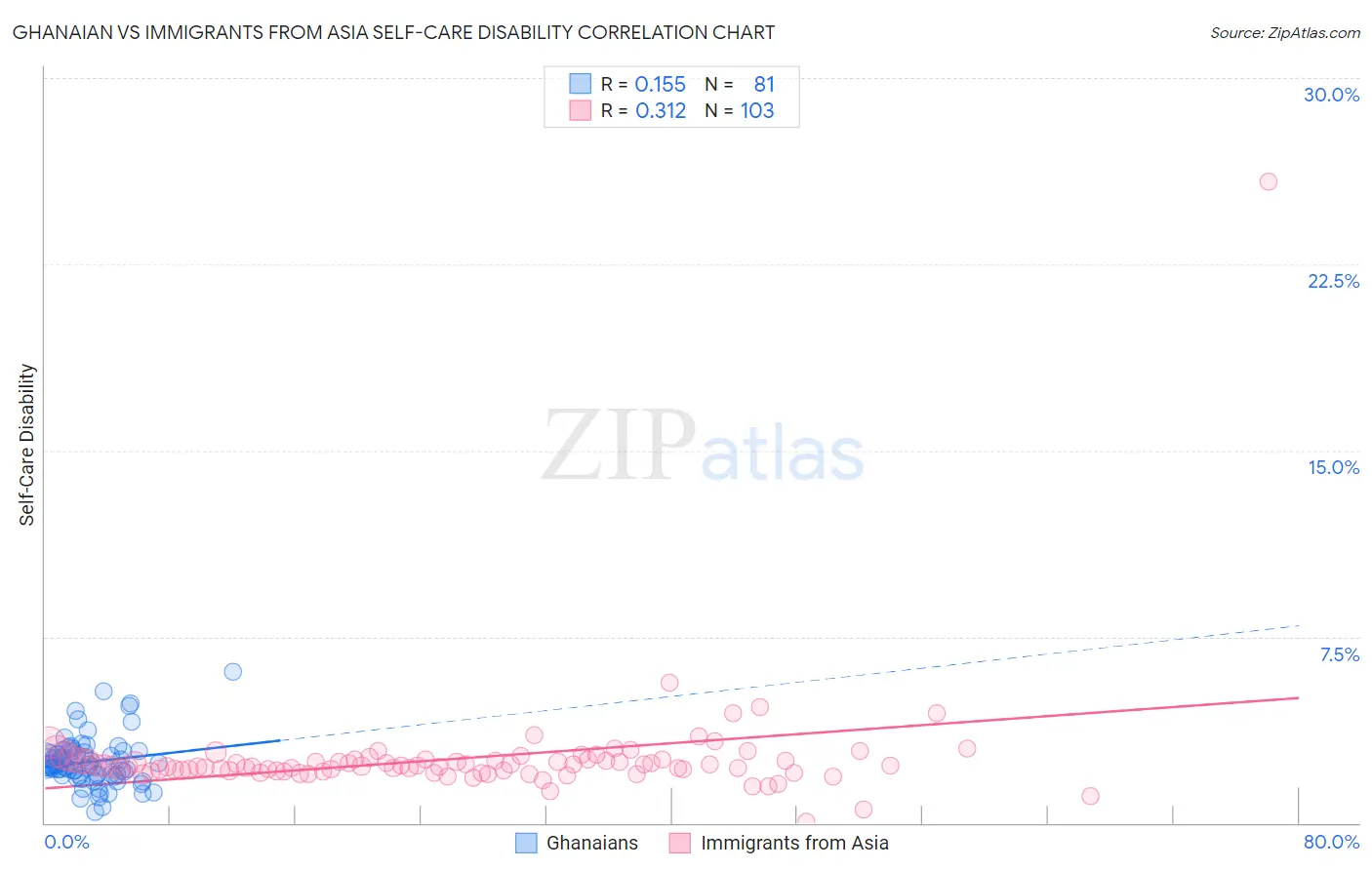Ghanaian vs Immigrants from Asia Self-Care Disability
COMPARE
Ghanaian
Immigrants from Asia
Self-Care Disability
Self-Care Disability Comparison
Ghanaians
Immigrants from Asia
2.5%
SELF-CARE DISABILITY
40.4/ 100
METRIC RATING
181st/ 347
METRIC RANK
2.4%
SELF-CARE DISABILITY
96.9/ 100
METRIC RATING
95th/ 347
METRIC RANK
Ghanaian vs Immigrants from Asia Self-Care Disability Correlation Chart
The statistical analysis conducted on geographies consisting of 190,499,518 people shows a poor positive correlation between the proportion of Ghanaians and percentage of population with self-care disability in the United States with a correlation coefficient (R) of 0.155 and weighted average of 2.5%. Similarly, the statistical analysis conducted on geographies consisting of 547,490,821 people shows a mild positive correlation between the proportion of Immigrants from Asia and percentage of population with self-care disability in the United States with a correlation coefficient (R) of 0.312 and weighted average of 2.4%, a difference of 4.7%.

Self-Care Disability Correlation Summary
| Measurement | Ghanaian | Immigrants from Asia |
| Minimum | 0.46% | 0.037% |
| Maximum | 6.1% | 25.8% |
| Range | 5.6% | 25.8% |
| Mean | 2.5% | 2.6% |
| Median | 2.3% | 2.3% |
| Interquartile 25% (IQ1) | 1.9% | 2.1% |
| Interquartile 75% (IQ3) | 2.8% | 2.5% |
| Interquartile Range (IQR) | 0.86% | 0.44% |
| Standard Deviation (Sample) | 0.97% | 2.4% |
| Standard Deviation (Population) | 0.97% | 2.4% |
Similar Demographics by Self-Care Disability
Demographics Similar to Ghanaians by Self-Care Disability
In terms of self-care disability, the demographic groups most similar to Ghanaians are Indonesian (2.5%, a difference of 0.040%), Maltese (2.5%, a difference of 0.14%), Salvadoran (2.5%, a difference of 0.20%), Yugoslavian (2.5%, a difference of 0.21%), and Hungarian (2.5%, a difference of 0.25%).
| Demographics | Rating | Rank | Self-Care Disability |
| Welsh | 50.0 /100 | #174 | Average 2.5% |
| Immigrants | Bosnia and Herzegovina | 49.6 /100 | #175 | Average 2.5% |
| Immigrants | Afghanistan | 47.6 /100 | #176 | Average 2.5% |
| Immigrants | Kazakhstan | 46.7 /100 | #177 | Average 2.5% |
| English | 46.2 /100 | #178 | Average 2.5% |
| Hungarians | 45.5 /100 | #179 | Average 2.5% |
| Indonesians | 41.2 /100 | #180 | Average 2.5% |
| Ghanaians | 40.4 /100 | #181 | Average 2.5% |
| Maltese | 37.5 /100 | #182 | Fair 2.5% |
| Salvadorans | 36.4 /100 | #183 | Fair 2.5% |
| Yugoslavians | 36.1 /100 | #184 | Fair 2.5% |
| Slavs | 34.3 /100 | #185 | Fair 2.5% |
| Immigrants | El Salvador | 33.0 /100 | #186 | Fair 2.5% |
| Irish | 28.7 /100 | #187 | Fair 2.5% |
| Immigrants | Oceania | 28.3 /100 | #188 | Fair 2.5% |
Demographics Similar to Immigrants from Asia by Self-Care Disability
In terms of self-care disability, the demographic groups most similar to Immigrants from Asia are Macedonian (2.4%, a difference of 0.010%), Immigrants from Latvia (2.4%, a difference of 0.050%), Immigrants from Chile (2.4%, a difference of 0.060%), Swiss (2.4%, a difference of 0.10%), and Immigrants from Poland (2.4%, a difference of 0.19%).
| Demographics | Rating | Rank | Self-Care Disability |
| Lithuanians | 98.0 /100 | #88 | Exceptional 2.4% |
| Immigrants | Congo | 98.0 /100 | #89 | Exceptional 2.4% |
| Immigrants | Czechoslovakia | 97.7 /100 | #90 | Exceptional 2.4% |
| Immigrants | Jordan | 97.7 /100 | #91 | Exceptional 2.4% |
| Icelanders | 97.4 /100 | #92 | Exceptional 2.4% |
| Immigrants | Latvia | 97.0 /100 | #93 | Exceptional 2.4% |
| Macedonians | 96.9 /100 | #94 | Exceptional 2.4% |
| Immigrants | Asia | 96.9 /100 | #95 | Exceptional 2.4% |
| Immigrants | Chile | 96.7 /100 | #96 | Exceptional 2.4% |
| Swiss | 96.6 /100 | #97 | Exceptional 2.4% |
| Immigrants | Poland | 96.4 /100 | #98 | Exceptional 2.4% |
| Immigrants | Israel | 96.1 /100 | #99 | Exceptional 2.4% |
| Europeans | 95.8 /100 | #100 | Exceptional 2.4% |
| Immigrants | Scotland | 95.7 /100 | #101 | Exceptional 2.4% |
| Croatians | 95.0 /100 | #102 | Exceptional 2.4% |